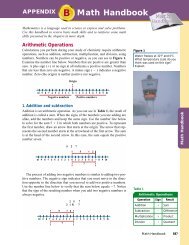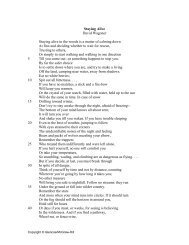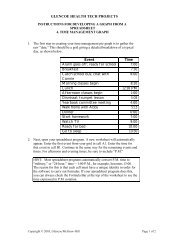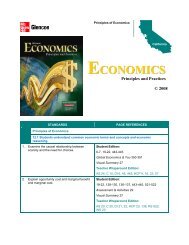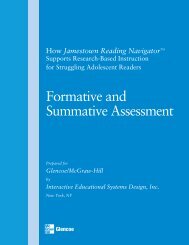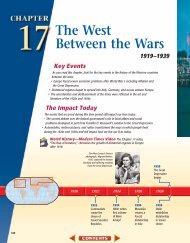Vocabulary - Research
Vocabulary - Research
Vocabulary - Research
You also want an ePaper? Increase the reach of your titles
YUMPU automatically turns print PDFs into web optimized ePapers that Google loves.
instructional<br />
recommendations<br />
• Assessment. Based on the variety of measures used to assess student vocabulary and the different results<br />
those measures can achieve, the National Reading Panel recommended that vocabulary should be assessed<br />
in multiple ways in the classroom. In particular, they argued that “the more closely the assessment<br />
matches the instructional context, the more appropriate the conclusions about the instruction will be”<br />
(NICHHD, 2000, p. 4-26).<br />
Specific Strategies<br />
• Preteaching vocabulary. Based on their review of the research literature, Baumann et al. (2003) recommended,<br />
“Preteach critical vocabulary necessary to comprehend selections students read in basal readers<br />
and in content area textbooks” (Baumann et al., 2003, p. 778).<br />
− This strategy was also recommended by the National Reading Panel review of vocabulary research.<br />
The NRP recommended direct instruction in “vocabulary items that are required for a<br />
specific text to be read as part of the lesson” (NICHHD, 2000, pp. 4-24–4-25, citing four studies).<br />
This included pre-instruction of vocabulary before the reading or lesson (p. 4-25, citing<br />
three studies). <br />
• Introducing word meanings in context. In contrast with the strategy of preteaching vocabulary, Beck et<br />
al. (2002) recommended, “[I]f the word is likely to affect comprehension of the story, then the most effective<br />
place to introduce word meanings may be at the moment the word is met in the text. . . . [E]ven if<br />
students have been introduced to a word’s meaning before reading, their memory for a newly introduced<br />
word meaning may still be rather tentative, making it difficult to bring that meaning into the text” (pp.<br />
42–43). This suggests a value to either teaching students new words in context, when students first encounter<br />
them, or reminding students of previously taught word meanings when they encounter them in<br />
context.<br />
• Student-friendly explanations of new words. One of the elements Beck and colleagues (2002) identified<br />
in the success of their instructional strategy with fourth-grade students was “student-friendly explanations<br />
of words,” which they characterized as incorporating “two basic principles . . . : (1) Characterize<br />
the word and how it is typically used. (2) Explain the meaning in everyday language” (p. 35).<br />
• Instructional contexts for vocabulary words. Another element Beck et al. (2002) recommended for introducing<br />
new words was providing an instructional context. Instructional contexts were described as differing<br />
from natural contexts in that the instructional context is deliberately constructed so that students<br />
can derive the correct meaning of the word from the context (p. 39). In other words, the surrounding<br />
words are deliberately designed to help students clarify the meaning of the new word.<br />
• Semantic mapping. Semantic mapping was identified by Baumann et al. (2003) as a specific researchsupported<br />
vocabulary instruction strategy that “organizes words related to a core concept into meaningful<br />
clusters” (p. 766).<br />
J a m e s t o w n R e a d i n g N a v i g a t o r<br />
− Typically, it involves “[1] Selecting a key or central word from a reading selection about which<br />
the teacher can assume that the students have some familiarity. [2] Having the students free<br />
associate on the core word and generate a list of related words. [3] Organizing the words into<br />
categories (and perhaps labeling them). [4] Discussing alternate ways of categorizing the words,<br />
adding new words, and forming new categories” (Baumann et al., 2003, p. 766).<br />
− Baumann et al. (2003) found that “in the majority of studies . . . semantic mapping . . . appear[s]<br />
to be [an] effective strateg[y] for teaching students the meanings of new words that lie within a<br />
semantically related category [with] which students are familiar. In addition, there is evidence<br />
that [this technique] also promote[s] passage comprehension and [is] effective with learners of<br />
diverse ages, ethnic backgrounds, and reading abilities” (Baumann et al., 2003, p. 767).<br />
Tomesen & Aarnoutse, 1998; White, Graves, & Slater, 1990; Dole, Sloan, & Trathen, 1995; Rinaldi, Sells, & McLaughlin, 1997.<br />
Brett, Rothlein, & Hurley, 1996; Wixson, 1986; Carney, Anderson, Blackburn, & Blessing, 1984.<br />
10




